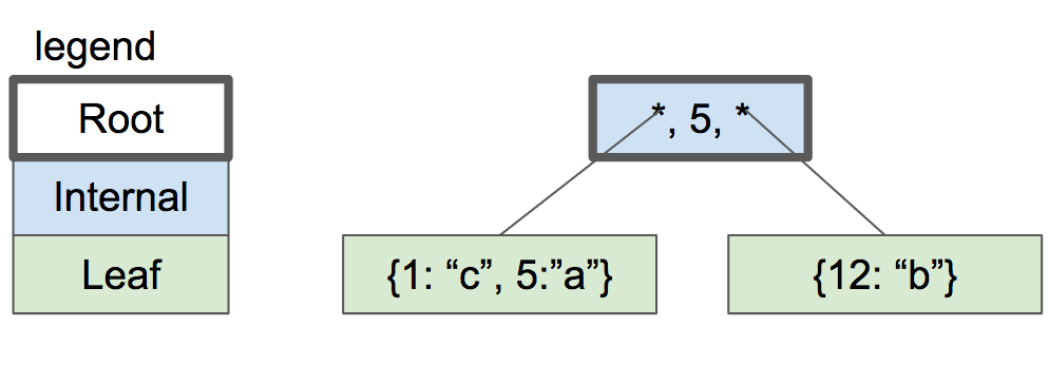实现一个简单的Database12(译文)
Part 12 扫描多级B-Tree
我们现在支持构建一个多级B-Tree,但是我们在程序中破坏了 select 语句。下面是一个插入15行数据并打印出来的测例。
+ it 'prints all rows in a multi-level tree' do
+ script = []
+ (1..15).each do |i|
+ script << "insert #{i} user#{i} person#{i}@example.com"
+ end
+ script << "select"
+ script << ".exit"
+ result = run_script(script)
+
+ expect(result[15...result.length]).to match_array([
+ "db > (1, user1, person1@example.com)",
+ "(2, user2, person2@example.com)",
+ "(3, user3, person3@example.com)",
+ "(4, user4, person4@example.com)",
+ "(5, user5, person5@example.com)",
+ "(6, user6, person6@example.com)",
+ "(7, user7, person7@example.com)",
+ "(8, user8, person8@example.com)",
+ "(9, user9, person9@example.com)",
+ "(10, user10, person10@example.com)",
+ "(11, user11, person11@example.com)",
+ "(12, user12, person12@example.com)",
+ "(13, user13, person13@example.com)",
+ "(14, user14, person14@example.com)",
+ "(15, user15, person15@example.com)",
+ "Executed.", "db > ",
+ ])
+ end但是现在当我们运行这个测例的时候,它实际上发生的是:
db > select
(2, user1, person1@example.com)
Executed.这很奇怪。它只打印了一行,而且数据看起来发生了损坏(注意输出的 id 和 username 不匹配)。
这个奇怪之处是因为 execute_select() 函数在表的开始位置执行,我们现在的实现 table_start() 函数返回根节点的第0个单元格。但是现在树的跟节点是一个内部节点,它并不包含任何数据行。打印出的数据是根节点当初作为叶子节点时遗留下的。execute_select() 函数应该返回的是最左侧的叶子节点的第0个单元格。
所以现在抛弃旧的实现:
-Cursor* table_start(Table* table) {
- Cursor* cursor = malloc(sizeof(Cursor));
- cursor->table = table;
- cursor->page_num = table->root_page_num;
- cursor->cell_num = 0;
-
- void* root_node = get_page(table->pager, table->root_page_num);
- uint32_t num_cells = *leaf_node_num_cells(root_node);
- cursor->end_of_table = (num_cells == 0);
-
- return cursor;
-}并且添加一个新的实现来搜索 key 0 (可能存在的最小的 key)。即使在表中 key 0不存在,这个方法也会返回最小id的位置(最左叶子节点的开始位置)。
+Cursor* table_start(Table* table) {
+ Cursor* cursor = table_find(table, 0);
+
+ void* node = get_page(table->pager, cursor->page_num);
+ uint32_t num_cells = *leaf_node_num_cells(node);
+ cursor->end_of_table = (num_cells == 0);
+
+ return cursor;
+}有了这些修改,测例仍然只打印出一个节点的行数:
db > select
(1, user1, person1@example.com)
(2, user2, person2@example.com)
(3, user3, person3@example.com)
(4, user4, person4@example.com)
(5, user5, person5@example.com)
(6, user6, person6@example.com)
(7, user7, person7@example.com)
Executed.
db >有15个条目,B-tree包含了一个内部节点和两个叶子节点,看起来就是下面的样子:

为了遍历整个表,我们需要在遍历到第一个节点的结尾时跳到第二个叶子节点(继续遍历)。为了能够这样,我们需要在叶子节点的头部保存一个叫做“next_leaf”的字段,这个字段将保存右边兄弟叶子节点的 page number。而最右侧的叶子节点中next_leaf字段将保存 0 值,来表示它没有兄弟节点(无论如何,page 0 是为表的根节点保留的)。
更新叶子节点的头部格式来包含新的字段:
const uint32_t LEAF_NODE_NUM_CELLS_SIZE = sizeof(uint32_t);
const uint32_t LEAF_NODE_NUM_CELLS_OFFSET = COMMON_NODE_HEADER_SIZE;
-const uint32_t LEAF_NODE_HEADER_SIZE =
- COMMON_NODE_HEADER_SIZE + LEAF_NODE_NUM_CELLS_SIZE;
+const uint32_t LEAF_NODE_NEXT_LEAF_SIZE = sizeof(uint32_t);
+const uint32_t LEAF_NODE_NEXT_LEAF_OFFSET =
+ LEAF_NODE_NUM_CELLS_OFFSET + LEAF_NODE_NUM_CELLS_SIZE;
+const uint32_t LEAF_NODE_HEADER_SIZE = COMMON_NODE_HEADER_SIZE +
+ LEAF_NODE_NUM_CELLS_SIZE +
+ LEAF_NODE_NEXT_LEAF_SIZE;添加一个方法来访问这个字段:
+uint32_t* leaf_node_next_leaf(void* node) {
+ return node + LEAF_NODE_NEXT_LEAF_OFFSET;
+}在初始化一个新的叶子节点的时候,设置 next_leaf 字段的默认值值为0:
@@ -322,6 +330,7 @@ void initialize_leaf_node(void* node) {
set_node_type(node, NODE_LEAF);
set_node_root(node, false);
*leaf_node_num_cells(node) = 0;
+ *leaf_node_next_leaf(node) = 0; // 0 represents no sibling
}每当分裂叶子节点时,更新同级兄弟节点的指针。老叶子节点的兄弟变成了新叶子节点,而新叶子节点的兄弟变成了旧叶子节点的兄弟。
@@ -659,6 +671,8 @@ void leaf_node_split_and_insert(Cursor* cursor, uint32_t key, Row* value) {
uint32_t new_page_num = get_unused_page_num(cursor->table->pager);
void* new_node = get_page(cursor->table->pager, new_page_num);
initialize_leaf_node(new_node);
+ *leaf_node_next_leaf(new_node) = *leaf_node_next_leaf(old_node);
+ *leaf_node_next_leaf(old_node) = new_page_num;增加几个新的字段,改变几个变量:
it 'prints constants' do
script = [
".constants",
@@ -199,9 +228,9 @@ describe 'database' do
"db > Constants:",
"ROW_SIZE: 293",
"COMMON_NODE_HEADER_SIZE: 6",
- "LEAF_NODE_HEADER_SIZE: 10",
+ "LEAF_NODE_HEADER_SIZE: 14",
"LEAF_NODE_CELL_SIZE: 297",
- "LEAF_NODE_SPACE_FOR_CELLS: 4086",
+ "LEAF_NODE_SPACE_FOR_CELLS: 4082",
"LEAF_NODE_MAX_CELLS: 13",
"db > ",
])现在,每当我们想将游标推进到叶子节点的末尾时,就可以检查叶子节点是否有兄弟节点。如果有,跳到兄弟节点。否则,我们就结束在表的末尾。
@@ -428,7 +432,15 @@ void cursor_advance(Cursor* cursor) {
cursor->cell_num += 1;
if (cursor->cell_num >= (*leaf_node_num_cells(node))) {
- cursor->end_of_table = true;
+ /* Advance to next leaf node */
+ uint32_t next_page_num = *leaf_node_next_leaf(node);
+ if (next_page_num == 0) {
+ /* This was rightmost leaf */
+ cursor->end_of_table = true;
+ } else {
+ cursor->page_num = next_page_num;
+ cursor->cell_num = 0;
+ }
}
}有了这些更改之后,我们实际上就可以打印 15 行了...
db > select
(1, user1, person1@example.com)
(2, user2, person2@example.com)
(3, user3, person3@example.com)
(4, user4, person4@example.com)
(5, user5, person5@example.com)
(6, user6, person6@example.com)
(7, user7, person7@example.com)
(8, user8, person8@example.com)
(9, user9, person9@example.com)
(10, user10, person10@example.com)
(11, user11, person11@example.com)
(12, user12, person12@example.com)
(13, user13, person13@example.com)
(1919251317, 14, on14@example.com)
(15, user15, person15@example.com)
Executed.
db >...但是有一行数据好像损坏了。
(1919251317, 14, on14@example.com)在做几次调试之后,我发现问题是因为在分裂叶子节点时的一个bug导致的:
@@ -676,7 +690,9 @@ void leaf_node_split_and_insert(Cursor* cursor, uint32_t key, Row* value) {
void* destination = leaf_node_cell(destination_node, index_within_node);
if (i == cursor->cell_num) {
- serialize_row(value, destination);
+ serialize_row(value,
+ leaf_node_value(destination_node, index_within_node));
+ *leaf_node_key(destination_node, index_within_node) = key;
} else if (i > cursor->cell_num) {
memcpy(destination, leaf_node_cell(old_node, i - 1), LEAF_NODE_CELL_SIZE);
} else {请记住,叶节点中的每个单元格首先包含一个键,然后包含一个值:

我们将新行(值)写入单元格的开头,键应该放在那里。这意味着用户名(username)的一部分进入了id部分(因为疯狂的大id)。在修改bug之后,我们终于按预期打印出了整个表格。
db > select
(1, user1, person1@example.com)
(2, user2, person2@example.com)
(3, user3, person3@example.com)
(4, user4, person4@example.com)
(5, user5, person5@example.com)
(6, user6, person6@example.com)
(7, user7, person7@example.com)
(8, user8, person8@example.com)
(9, user9, person9@example.com)
(10, user10, person10@example.com)
(11, user11, person11@example.com)
(12, user12, person12@example.com)
(13, user13, person13@example.com)
(14, user14, person14@example.com)
(15, user15, person15@example.com)
Executed.
db >哇哦!一个又一个BUG,但我们正在取得进展。直到下次。
文章转载自公众号:GreatSQL社区




















